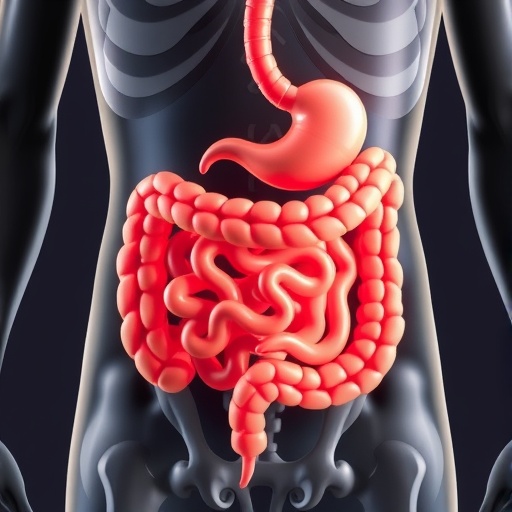A groundbreaking pilot study published in Nature Metabolism is shedding new light on the intricate mechanisms by which the upper-gastrointestinal (GI) tract metabolite profile influences the body’s glycaemic and satiety responses following consumption of meals with vastly different structural compositions. This research, spearheaded by Cai, Tejpal, Tashkova, and their multidisciplinary team, unravels how metabolites within the early digestive system component act as critical biochemical messengers, modulating post-meal blood sugar regulation and feelings of fullness. Such insights could revolutionize nutritional science and personalized dietary interventions by linking gut chemistry to metabolic outcomes in unprecedented ways.
The study delves deeply into the molecular landscape of the upper GI tract, a region comprising the stomach and proximal segments of the small intestine, where initial digestion and nutrient signaling occur. Previous research has often overlooked this anatomical niche’s metabolite milieu, focusing more heavily on distal gut microbiota and systemic metabolic byproducts. However, Cai and colleagues propose that the upper GI metabolite profile acts as a frontline interface, integrating dietary form—whether solid, liquid, or semi-solid—with biochemical signals that inform systemic metabolic pathways governing glucose uptake and appetite regulation.
To explore this hypothesis, the researchers designed a controlled trial involving meals with dramatically contrasting physical and chemical structures, including variations in matrix density, macronutrient composition, and texture. By systematically analyzing metabolite concentrations in the upper GI samples collected post-ingestion, the study combined state-of-the-art metabolomics with advanced glycaemic monitoring and subjective satiety assessments. The comprehensive approach allowed the team to draw correlations between specific metabolite signatures and physiological responses critical to energy homeostasis.
.adsslot_5ZR2zTjthS{ width:728px !important; height:90px !important; }
@media (max-width:1199px) { .adsslot_5ZR2zTjthS{ width:468px !important; height:60px !important; } }
@media (max-width:767px) { .adsslot_5ZR2zTjthS{ width:320px !important; height:50px !important; } }
ADVERTISEMENT
One of the pivotal findings reveals that the biotransformation of complex meal structures in the upper GI tract produces distinctive metabolites that directly influence glucose excursion patterns in the bloodstream. For instance, meals rich in complex carbohydrates but differing in physical consistency yielded divergent profiles of oligosaccharides and simple sugars in the proximal intestine. These metabolite variations were closely linked to altered insulin secretion dynamics and glycaemic peaks, highlighting a biochemical feedback system at the digestive-absorptive interface.
The technical rigor of the metabolomic analysis involved ultra-high-performance liquid chromatography coupled with tandem mass spectrometry (UHPLC-MS/MS), enabling detection and quantification of hundreds of metabolites with exceptional sensitivity. This high-resolution profiling exposed subtle but meaningful shifts in metabolites including short-chain fatty acids, branched-chain amino acids, and monoacylglycerols, all known to participate in metabolic signaling cascades. By coupling these data with dynamic glycaemic monitoring, the study mapped a complex biochemical network linking ingestive behavior with systemic metabolic control.
From a physiological perspective, the involvement of the upper GI metabolite milieu in modulating postprandial glucose responses challenges the prevailing dogma that primarily attributes glycaemic control to pancreatic function and peripheral glucose uptake. Cai and colleagues’ findings position the upper digestive tract as a crucial metabolic sensor, where nutrient-derived chemical signals initiate regulatory events with systemic consequences. This reconceptualization has profound implications for managing metabolic disorders such as diabetes and obesity, conditions characterized by impaired glucose homeostasis and dysregulated appetite.
Moreover, the pilot nature of the study underscores the potential for larger-scale research to unravel individual variability in metabolite profiles and their correlation with metabolic phenotypes. Personalization of nutrition may soon incorporate real-time assessment of upper GI metabolites, offering bespoke dietary formulations tailored to optimize glycaemic control and satiety for each individual. This integrative framework could harness the biological complexity of digestion to combat chronic metabolic diseases with precision.
The multidisciplinary team’s integrated approach—bridging gastroenterology, metabolomics, endocrinology, and nutritional science—exemplifies the future of metabolic research. By exploring the tangible but understudied biochemical environment of the upper digestive tract, the study reconnects physiological reality to molecular detail, moving beyond reductionist views of metabolism toward holistic understanding. The findings could catalyze innovations in functional food design, therapeutic targeting, and comprehensive metabolic monitoring.
An intriguing aspect of the study’s methodology is the temporal resolution of the metabolome assessments. Samples were collected at multiple time points subsequent to meal consumption, enabling dynamic tracking of metabolite fluxes as digestion progressed. This approach revealed not only static metabolite presence but also kinetic patterns corresponding to phases of enzymatic breakdown, absorption, and cellular signaling. Such longitudinal data are crucial for identifying causative links rather than mere associations within metabolic networks.
In addition to biochemical analyses, the study employed subjective satiety scoring and appetite questionnaires alongside continuous glucose monitoring. This multidimensional design enhanced the interpretive power of metabolic data by integrating physiological sensations and clinical metrics. The congruence between elevated levels of certain lipid-derived metabolites in the upper GI lumen and reported fullness ratings bolsters the concept that early digestive chemical signals translate into perceptible changes in hunger regulation.
The researchers also highlighted the relevance of food structure beyond chemical composition alone. Their results suggest that the physical form of a meal affects digestive kinetics, enzymatic accessibility, and hence metabolite generation profiles. For example, solid meals elicited a more gradual metabolite release and attenuated glycaemic excursions compared to liquid variants containing the same nutrient quantities. This finding reaffirms the importance of considering food matrix effects in metabolic research and dietary guidelines.
While promising, the researchers acknowledge limitations inherent in pilot studies, including small sample sizes and the complexity of isolating cause-effect relationships in vivo. The study’s constraints leave open questions regarding the reproducibility of metabolite signatures across diverse populations and meal types. Future investigations will need to scale these findings, incorporate varied demographic cohorts, and employ interventional designs to fully elucidate the clinical significance of upper GI metabolite profiles.
Nevertheless, this pioneering work opens an exciting frontier in nutritional and metabolic science. By positioning the upper gastrointestinal tract’s metabolite landscape as a key mediator of metabolic health, Cai and colleagues chart a new course for research and application. The potential to tailor meals not just by nutrient content but by their ensuing biochemical digestive signatures offers a powerful tool for improving human health at the molecular and systemic levels.
In the broader context of metabolic diseases, which impose staggering healthcare burdens worldwide, understanding the nexus between digested food structure, metabolite signaling, and systemic metabolic responses could transform prevention and treatment strategies. The study’s insights align with emerging paradigms emphasizing holistic gut-metabolism interactions rather than simplistic nutrient counting alone. This integrative vision beckons a paradigm shift in how science, medicine, and society approach nutrition as a determinant of metabolic well-being.
As research progresses, further characterization of the specific metabolites responsible for modulating glycaemic and satiety responses will enable novel biomarker development. Such biomarkers could be employed in clinical settings to assess digestive efficiency, predict metabolic risk, or monitor intervention outcomes. Moreover, the principles uncovered may inspire novel pharmacological or nutraceutical agents designed to mimic or enhance beneficial upper GI metabolite profiles, representing a convergence of metabolic and digestive health innovation.
In conclusion, Cai, Tejpal, Tashkova, and their team’s pilot study provides compelling evidence that the metabolite environment within the upper gastrointestinal tract orchestrates critical aspects of metabolic regulation following meal consumption. By integrating sophisticated metabolomic techniques with glycaemic and satiety assessments, this research offers a new lens through which to view digestion as an active metabolic signaling event. This knowledge lays the groundwork for targeted nutritional strategies and metabolic health management that embrace the complexity and dynamism of human digestive biochemistry, heralding a new era in metabolic research and clinical nutrition.
Subject of Research: Regulation of glycaemic and satiety responses by upper-gastrointestinal tract metabolite profiles in relation to meal structure.
Article Title: Upper-gastrointestinal tract metabolite profile regulates glycaemic and satiety responses to meals with contrasting structure: a pilot study.
Article References:
Cai, M., Tejpal, S., Tashkova, M. et al. Upper-gastrointestinal tract metabolite profile regulates glycaemic and satiety responses to meals with contrasting structure: a pilot study. Nat Metab (2025). https://doi.org/10.1038/s42255-025-01309-7
Image Credits: AI Generated
Tags: appetite regulation mechanismsbiochemical messengers in digestiondigestive system metabolite profileglycaemic response and meal compositiongut metabolites and blood sugar regulationimpact of meal structure on metabolismmolecular mechanisms of nutrient signalingnutritional science advancementspersonalized dietary interventionspilot study on gut chemistrysatiety signals and gastrointestinal healthupper gastrointestinal tract metabolism





